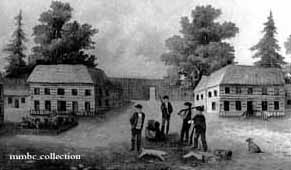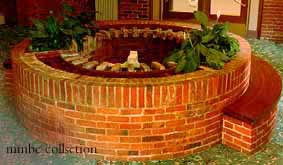
HBC company flag
mmbc 996.572.0001

The Hudson's Bay Company (H.B.C.) had a leading role in the development of the city of Victoria. After amalgamating with the North West Company in 1821, the H.B.C. was in control of the fur trade from New Caledonia (central British Columbia) to Oregon. Various forts were established in these regions and furs from these posts were collected at Fort Vancouver which was situated along the Columbia River. From Fort Vancouver the furs were shipped by sea.
| After a series of negotiations between Britain, the United States, and Russia, British territory was defined as the land between the 49th and 54° 40' north parallels. However, the question of who controlled the land between 42° and 54° 40' west of the mountains was not resolved until 1846 with the Oregon Treaty. This treaty extended British lands westward along the 49th parallel dipping southward at Vancouver Island, splitting British and American territory through the Straits of Georgia, Haro, and Juan de Fuca, to the open ocean. |
 Land claims in 1846 |
 Sir James Douglas mmbc collections |
The British foresaw the loss of the Columbia River region to the United States and had already sent James Douglas, Chief Factor of the Western Department of the H.B.C., to choose a site for new northern headquarters on Vancouver Island. |
| In 1842 Douglas chose 'Port Camosun' on southern Vancouver Island because access to the mainland and the Pacific Ocean was convenient, and because the agricultural potential was tremendous. A fort was built on this site (now Victoria's Inner Harbour area) in 1843 and 'Port Camosun' was renamed Fort Victoria after Queen Victoria. Today, remnants of the H.B.C. can still be seen. The historic vessel that initially brought Douglas to this area was the S.S. Beaver. |
 Fort Victoria mmbc 4538P |
| H.B.C. headquarters were finally transferred to Fort Victoria in 1849. The first British vessel to sail direct from England to the new Pacific port of Victoria was the Vancouver in 1845. |
 The original well of Fort Victoria located in the Rithet building on Wharf St. | British naval vessels were soon stopping in the area (mainly Esquimalt Harbour) buying supplies from Victoria, and British ships were being directed to this port to distribute goods for coastal trade. |
Goods such as salmon, coal, lumber, and shingles were soon being shipped from Victoria while goods such as sugar, molasses and salt were being shipped to Victoria from the Sandwich Islands.
| At this time, the British government agreed to an arrangement whereby the H.B.C. was granted Vancouver Island in return for colonizing it over a period of five years as well as paying a small rental fee for ten years to maintain exclusive trading privileges. |
 Crest of the H.B.C. mmbc 4580P |
Douglas helped to broaden the H.B.C.'s interests beyond the collection of furs which by this time had become a less popular item. Appointed governor of the colony of Vancouver Island in 1851, he was required to retire from H.B.C. service in 1858 when he also became governor of the colony of British Columbia (the mainland). |
|
|
 An advertisment of Tiedemann's 1887 |
Hermann Otto Tiedemann, who designed the Provincial Courthouse in Victoria which now houses the Maritime Museum of British Columbia, painted a scene looking towards Victoria from the Songhees village area in 1860. Many First Nations people settled across from Fort Victoria between 1850 and 1852 where they built large cedar-planked houses. These people were a mixed group of autonomous bands named the Songish or Songhees, and the area their village occupied is still referred to as the 'Songhees'. This area is located in on the west side of modern downtown Victoria, British Columbia. |

|
The city of Victoria was incorporated in 1862. At this time there were 1500 buildings in the city and the population was increasing dramatically. The colonies of British Columbia and Vancouver Island were united in 1866, and in 1868 the city of Victoria was declared the capital of the new colony of British Columbia. |

|
 Visit Fort Victoria
Visit Fort Victoria


![[English]](../simages/english.gif)
|

![[French]](../simages/french.gif)
|

![[Credits]](../simages/credit.gif)
|

![[Feedback]](../simages/feedback.gif)
|